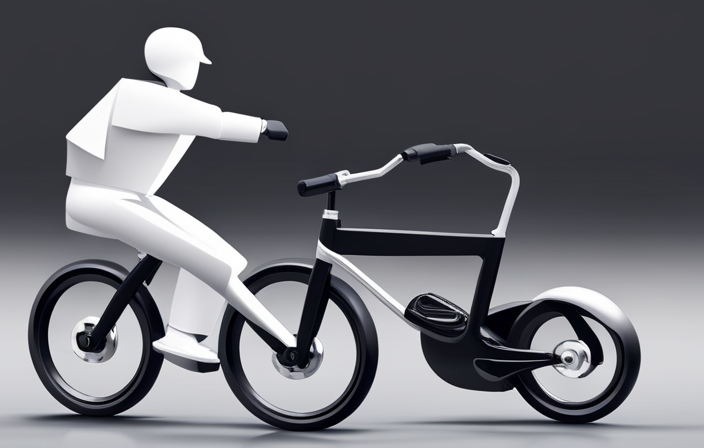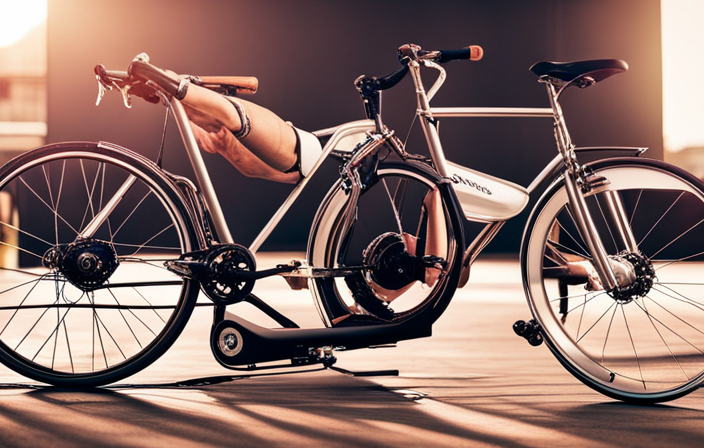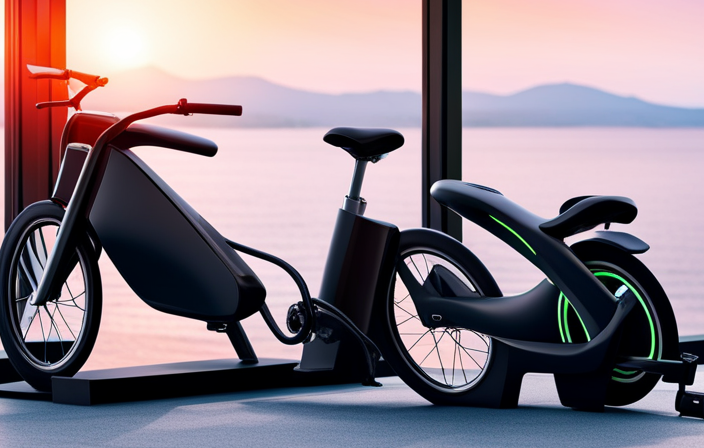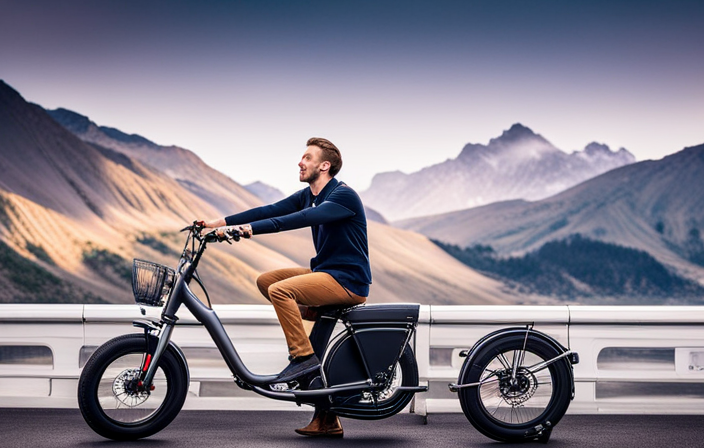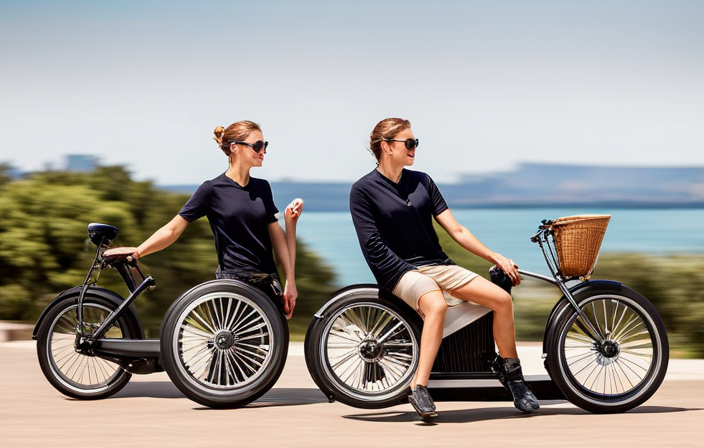Riding an electric bike is like having a personal wind at your back, effortlessly propelling you forward. But just how much do you have to pedal to keep the wheels turning?
In this article, I’ll delve into the world of electric bikes and uncover the secrets behind pedal-assist and throttle-controlled models. We’ll explore how electric motors assist with pedaling effort, the impact on battery life, and the benefits of pedaling for your health and fitness.
So hop on, let’s discover the perfect balance between power and pedaling on an electric bike.
Key Takeaways
- Pedaling on an electric bike allows for more effort, resulting in a more efficient and faster ride.
- Finding the right balance between pedaling and motor assistance optimizes performance and reduces fatigue.
- Pedaling on an electric bike provides health and fitness benefits, including a low-impact cardiovascular workout and improved muscle strength and endurance.
- Maintaining a consistent pedaling cadence and adjusting gears for a smooth and efficient ride are key to enjoying the freedom and flexibility of electric biking.
Understanding the Basics of Electric Bikes
To understand the basics of electric bikes, you’ll need to know how much you have to pedal. Electric bikes are designed to provide assistance to the rider, making it easier to pedal and travel longer distances. The amount of pedaling required depends on the type of electric bike you choose and your personal preferences.
When it comes to electric bike maintenance, it’s important to note that regular maintenance is still required, just like with a regular bicycle. This includes checking the tires, brakes, and gears, as well as keeping the battery charged and clean. It’s also crucial to choose the right electric bike for your needs, considering factors such as the terrain you’ll be riding on and the distance you’ll be traveling.
Now, let’s delve into the difference between pedal-assist and throttle-controlled electric bikes.
The Difference Between Pedal-Assist and Throttle-Controlled Electric Bikes
The main distinction lies in the method of control – pedal-assist and throttle-controlled electric bikes. Pedal-assist electric bikes, also known as pedelecs, require the rider to pedal in order to activate the motor. These bikes have sensors that detect the rider’s pedaling cadence and provide assistance accordingly. On the other hand, throttle-controlled electric bikes allow the rider to engage the motor using a throttle, similar to a motorcycle. This means that the rider can choose to pedal or simply rely on the motor for propulsion.
| Pedal-Assist Electric Bikes | Throttle-Controlled Electric Bikes |
|---|---|
| Requires pedaling to activate the motor | Can be propelled without pedaling |
| Provides assistance based on pedaling cadence | Offers instant and continuous power |
| Offers a more natural riding experience | Allows for easier control and acceleration |
Throttle-controlled electric bikes have the advantage of providing instant and continuous power, making them ideal for situations where quick acceleration is necessary. However, pedal-assist electric bikes offer a more natural riding experience and encourage physical activity.
Understanding the difference between these two types of electric bikes is crucial to determine which one suits your needs and preferences. In the next section, we will explore how electric motors assist with pedaling effort.
How Electric Motors Assist with Pedaling Effort
Electric motors on e-bikes help reduce the effort required when pedaling. They are designed to assist the rider by providing additional power and torque, making it easier to pedal uphill or against strong headwinds. Here are three ways electric motors assist with pedaling effort:
-
Electric motor efficiency: The motor efficiently converts electrical energy from the battery into mechanical power, which is then used to assist with pedaling. This means that you can pedal with less effort while still maintaining a good speed.
-
Weight impact: The weight of the e-bike itself can affect the pedaling effort. However, the electric motor compensates for the added weight by providing extra power, making it feel lighter and easier to pedal.
-
Power options: Most e-bikes offer different power modes, allowing you to choose the level of assistance you need. This gives you the flexibility to adjust the amount of effort required while riding.
Understanding how electric motors assist with pedaling effort is crucial for maximizing the benefits of an e-bike. It also highlights the importance of pedaling for battery life, which we will explore in the next section.
The Importance of Pedaling for Battery Life
Pedaling is essential for maximizing the battery life of an e-bike. While the electric motor provides assistance, it is not meant to replace pedaling entirely. By actively pedaling, you are not only contributing to the overall effort of the ride, but you are also conserving the battery power.
The more you pedal, the less strain you put on the battery, which in turn prolongs its life. Additionally, pedaling helps to distribute the workload between the motor and your own physical effort, preventing the motor from overworking and potentially overheating.
Finding the right balance between pedaling and motor assistance is crucial for optimizing battery life. In the next section, we will explore how to determine the appropriate pedal-assist level for your riding style, allowing you to have an enjoyable and energy-efficient e-bike experience.
Finding the Right Pedal-Assist Level for Your Riding Style
To determine the appropriate pedal-assist level for your riding style, consider how much effort you want to exert while riding an e-bike. Finding the right pedaling technique is crucial in maximizing battery efficiency.
Some riders prefer a more leisurely ride and may opt for a lower pedal-assist level, allowing the motor to do most of the work. This is great for cruising along flat terrains or when you want to conserve energy.
On the other hand, if you enjoy a more active ride and want to get a workout while still having the assistance of the motor, a higher pedal-assist level could be the right choice. This requires more effort on your part but can be rewarding for those who enjoy a challenge.
Understanding your riding style and preferences will help you find the perfect balance between exertion and assistance.
Transitioning into the next section, let’s now explore how terrain and riding conditions affect pedaling effort.
How Terrain and Riding Conditions Affect Pedaling Effort
Terrain and riding conditions can greatly impact the amount of effort required while riding an e-bike. Balancing pedaling effort is crucial for optimizing battery usage. When riding on hilly terrain, such as steep inclines or rough off-road trails, more pedaling effort is needed to maintain a consistent speed. On the other hand, when riding on flat roads or downhill slopes, less pedaling effort is required as the bike’s motor takes over. Riding conditions, such as headwinds or tailwinds, also affect pedaling effort. In strong headwinds, more effort is needed to overcome the resistance, while in tailwinds, pedaling becomes easier. By adapting to the terrain and riding conditions, riders can find the right balance between pedaling and motor assistance, extending the range of their e-bike and maximizing their riding experience. Transitioning into the subsequent section, the role of gears in determining pedaling intensity will be explored.
The Role of Gears in Determining Pedaling Intensity
When riding an e-bike, adjusting the gears allows you to control the intensity of your pedaling effort. Gearing advantages play a crucial role in enhancing the overall riding experience.
By shifting to a lower gear, you can tackle steep inclines more easily, as it reduces the resistance and allows you to pedal with less effort. Conversely, selecting a higher gear enables you to achieve higher speeds on flat terrain, as it maximizes your pedaling efficiency.
The ability to adjust gears not only provides a comfortable and efficient ride, but it also enables you to conserve battery power. By finding the optimal gear for different riding conditions, you can make the most out of your e-bike’s performance.
With a solid understanding of gear selection, let’s delve into how fitness levels impact pedaling on an electric bike.
How Fitness Levels Impact Pedaling on an Electric Bike
Improving your fitness levels can greatly influence your pedaling experience on an e-bike. When it comes to electric bikes, having a higher fitness level allows you to put in more effort while pedaling, resulting in a more efficient ride.
With increased fitness, you’ll find that you can maintain a faster pace and tackle steeper inclines with ease. Your muscles will be stronger and more conditioned, allowing you to pedal with less fatigue and exertion.
Additionally, a higher fitness level can help you maintain a consistent and steady pedaling rhythm, which is essential for efficient riding. By improving your fitness levels, you’ll be able to maximize the benefits of an electric bike and enjoy a more enjoyable and rewarding riding experience.
Now, let’s explore some tips for efficient pedaling on an electric bike.
Tips for Efficient Pedaling on an Electric Bike
To pedal efficiently on an e-bike, it’s important to maintain a consistent and steady rhythm. Finding the right cadence is key, as it allows you to maximize your pedaling power while still benefiting from the electric motor assistance.
Here are three tips to help you maintain a steady pedaling rhythm on an electric bike:
-
Start with a lower gear: Begin in a lower gear to make it easier to maintain a consistent pedaling cadence. This will prevent you from exerting too much effort and help you find your ideal rhythm.
-
Relax your upper body: Keep your upper body relaxed and let your legs do the work. Tension in your upper body can interfere with your pedaling efficiency and make it harder to maintain a steady rhythm.
-
Practice smooth transitions: Smooth transitions between pedaling and motor assistance can help you maintain your momentum and avoid sudden jerks. Gradually decrease or increase your pedaling effort to smoothly transition between manual and electric power.
By following these tips, you can ensure efficient pedaling on an electric bike while maintaining a steady rhythm. Balancing pedaling and motor assistance for optimal performance is essential for a smooth and enjoyable ride.
Balancing Pedaling and Motor Assistance for Optimal Performance
Finding the right balance between manual pedaling and motor assistance is crucial for achieving optimal performance on an e-bike. When riding an electric bike, it’s important to find the optimal speed that allows you to pedal comfortably while still benefiting from the motor’s assistance.
This balance not only ensures a smooth and enjoyable ride but also helps increase the battery life of your e-bike. By finding the sweet spot where you are actively pedaling but also utilizing the motor’s power efficiently, you can maximize the distance you can travel before needing to recharge.
In the next section, we will explore how adjusting your pedaling technique can further enhance your comfort and efficiency on an electric bike.
Adjusting Pedaling Technique for Maximum Comfort and Efficiency
Adjusting your pedaling technique can greatly enhance your comfort and efficiency on an e-bike. One important aspect to consider is the seat position. Finding the right height and angle can make a significant difference in how your body aligns with the pedals and handlebars, reducing strain on your joints and allowing for a smoother pedal stroke.
Additionally, paying attention to your pedal cadence is key. Maintaining a consistent and efficient rhythm can help you optimize the power assistance from the motor and prevent unnecessary fatigue. Experiment with different pedal cadences to find what feels most comfortable and efficient for you.
By making these adjustments, you can achieve a more enjoyable and effective riding experience on your electric bike.
Now, let’s dive into overcoming common misconceptions about electric bikes and pedaling.
Overcoming Common Misconceptions about Electric Bikes and Pedaling
Don’t let misconceptions about e-bikes and pedaling hold you back from experiencing the joy and benefits of electric biking.
One common misconception is that electric bikes require less physical effort. While it’s true that the motor provides assistance, pedaling is still necessary. Finding the right pedaling cadence is key to getting the most out of your electric bike. It’s important to maintain a steady rhythm, neither pushing too hard nor pedaling too lightly. By doing so, you can maximize your efficiency and range.
Additionally, pedaling on an electric bike offers numerous health and fitness benefits. It provides a low-impact cardiovascular workout, strengthens your leg muscles, and improves overall endurance. So, let go of the misconception that electric bikes are for lazy riders, and embrace the opportunity to improve your fitness while enjoying the ride.
Now, let’s delve into the benefits of pedaling on an electric bike for health and fitness.
The Benefits of Pedaling on an Electric Bike for Health and Fitness
Now that we have debunked the common misconceptions about electric bikes and pedaling, let’s dive into the benefits of pedaling on an electric bike for health and fitness.
When it comes to staying active and improving our overall well-being, pedaling on an electric bike can offer a range of advantages. Not only does it provide a cardiovascular workout, but it also helps to strengthen our leg muscles and improve our balance and coordination.
The beauty of an electric bike is that it allows us to adjust the level of assistance provided by the motor, so we can gradually increase the amount of effort we put into pedaling as our fitness improves. This flexibility allows us to tailor our workouts to our individual needs and goals.
As we explore the differences in pedaling effort between electric bikes and traditional bicycles, we will uncover even more fascinating insights into the world of electric biking.
Comparing Pedaling Effort on Electric Bikes and Traditional Bicycles
When riding an electric bike compared to a traditional bicycle, the level of effort required for pedaling can be noticeably different. One key difference is the ability to find the right gear. Electric bikes often come with multiple speed settings, allowing you to choose a gear that suits your pedaling style and the terrain you’re riding on.
This means you can adjust the level of assistance provided by the motor, making it easier or harder to pedal depending on your preference. Additionally, maintaining a consistent pedaling cadence is important when riding an electric bike. This helps to maximize the efficiency of the motor and ensures a smooth and comfortable ride.
By finding the right gear and maintaining a consistent cadence, you can optimize the performance of your electric bike. With these factors in mind, let’s explore the freedom and flexibility of pedaling on an electric bike.
Enjoying the Freedom and Flexibility of Pedaling on an Electric Bike
Experience the exhilarating freedom and unmatched flexibility of effortlessly gliding through various terrains on an electric bike.
When riding an electric bike, finding the right gear ratio is crucial for a smooth and efficient ride. By adjusting the gears to match the terrain and your desired speed, you can optimize your pedaling effort.
Maintaining a consistent pedaling cadence is also important. This means keeping a steady rhythm and not exerting too much force on the pedals.
With an electric bike, you can enjoy the benefits of both power-assisted pedaling and traditional biking. The electric motor provides a boost when you need it, making uphill climbs and long distances more manageable. However, it’s important to remember that you still need to pedal, albeit with less effort, to fully enjoy the electric bike experience.
So hop on an electric bike and embrace the freedom and flexibility it offers while effortlessly cruising through different terrains.
Frequently Asked Questions
Can I ride an electric bike without pedaling at all?
Yes, you can ride an electric bike without pedaling at all. The riding style depends on your preference. However, keep in mind that not pedaling will drain the battery faster, reducing the overall battery life.
Does pedaling on an electric bike require the same amount of effort as on a traditional bicycle?
When riding an electric bike, the energy expenditure is significantly reduced compared to a traditional bicycle. The pedal assist feature greatly reduces the perceived exertion, allowing me to enjoy longer rides with less effort.
How does the pedal-assist level affect the amount of effort required for pedaling?
The pedal assist level on electric bikes greatly affects the effort required for pedaling. As the pedal assist level increases, the motor provides more assistance, reducing the physical effort needed to pedal and enhancing the overall cycling experience.
Is it possible to adjust the motor assistance to make pedaling easier or harder?
Yes, it is possible to adjust the motor assistance on an electric bike. By adjusting the motor assistance, you can make pedaling easier or harder, depending on your preference. This adjustment can have a significant impact on your cycling performance.
Can pedaling on an electric bike improve my fitness and health as much as traditional cycling?
Pedaling on an electric bike can improve fitness and health similar to traditional cycling. It offers cardiovascular benefits and can aid in weight loss. The motor assistance can be adjusted to make pedaling easier or harder.
Conclusion
In conclusion, pedaling on an electric bike is not only necessary but also beneficial. Contrary to common misconceptions, electric bikes require pedaling to activate the motor assistance.
One interesting statistic to consider is that on average, electric bikes can provide a range of 40-100 miles on a single charge, depending on the level of pedal-assist used. This means that with regular pedaling, riders can enjoy extended rides and explore further distances with ease.
So, hop on an electric bike, pedal away, and experience the freedom and flexibility it offers!
